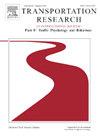Overtaking automated truck platoons: Effects of platoon organisations and traffic situation on driving behaviours of nearby manual vehicle drivers
IF 3.5
2区 工程技术
Q1 PSYCHOLOGY, APPLIED
Transportation Research Part F-Traffic Psychology and Behaviour
Pub Date : 2025-02-01
DOI:10.1016/j.trf.2025.01.026
引用次数: 0
Abstract
Automated truck platooning is a promising technology that is expected to be mainstream within the next decade. For the foreseeable future, automated truck platoons will coexist and interact with human drivers. Resembling a train-like formation, automated truck platoons may present challenges for drivers wishing to overtake them, and it is not currently clear how these new formations affect driver behaviour. Therefore, this paper aims to examine driver behaviours in the overtaking process under various platoon organisations. A high-fidelity driving simulation experiment was conducted to investigate the influence of platoon speed (80 km/h and 100 km/h), size (three trucks and five trucks), inner gap (5 m and 25 m) and the surrounding traffic situation, e.g., the presence of a lead vehicle, on drivers’ overtaking behaviour. Thirty-eight participants were recruited in the experiment. Results revealed that compared to 80 km/h conditions, the 100 km/h conditions prompted more drivers to exhibit extreme behaviours—either failing to overtake or performing a risky overtaking. Regarding platoon size, drivers tended to deviate farther from the lane center to maintain a larger lateral distance from the platoon under five-truck conditions. With respect to the inner gap, a 25 m inner gap significantly reduced the proportion of successful overtaking maneuvers. Moreover, in critical conditions, a 5 m inner gap extended drivers’ response time but did not significantly impact collision probability. The presence of the lead vehicle increased drivers’ mental workload and impaired longitudinal stability. These findings may offer insights for managing automated truck platoons. For instance, the platoon speed and inner gap can be regulated in different traffic conditions, to optimize efficiency, while ensuring safety for all road users.
求助全文
约1分钟内获得全文
求助全文
来源期刊
CiteScore
7.60
自引率
14.60%
发文量
239
审稿时长
71 days
期刊介绍:
Transportation Research Part F: Traffic Psychology and Behaviour focuses on the behavioural and psychological aspects of traffic and transport. The aim of the journal is to enhance theory development, improve the quality of empirical studies and to stimulate the application of research findings in practice. TRF provides a focus and a means of communication for the considerable amount of research activities that are now being carried out in this field. The journal provides a forum for transportation researchers, psychologists, ergonomists, engineers and policy-makers with an interest in traffic and transport psychology.

 求助内容:
求助内容: 应助结果提醒方式:
应助结果提醒方式:


